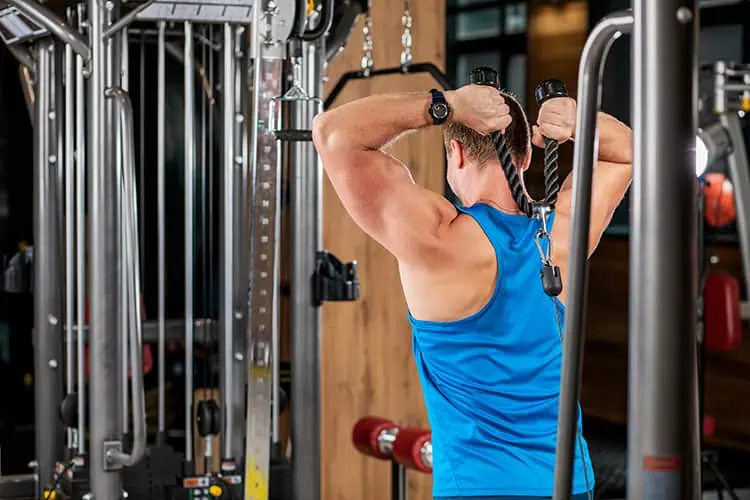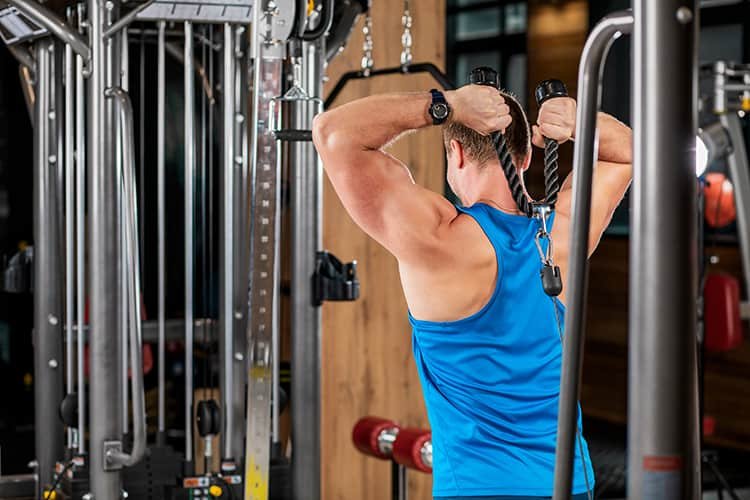
The overhead triceps extension, often referred to simply as an overhead triceps extension, is a powerful exercise that targets the development of the triceps. The triceps, located at the back of the upper arm, are vital for pushing movements, stability and overall arm aesthetics. This exercise specifically targets the long head of the triceps, providing a complete workout that builds strength and muscle tone. In this detailed guide, we’ll walk you through the steps to perform this exercise correctly, the benefits it offers, variations to keep your workouts fresh, and some common mistakes to avoid.
The overhead cable pull triceps extension
Before diving into the specifics of exercise, it is essential to understand its anatomy and benefits. The triceps brachii has three heads: the long, medial, and lateral heads. The overhead triceps extension uniquely targets the long head, which is often under-employed in other triceps exercises. Engaging this muscle head is key to achieving balanced hand development and improving functional strength.
Benefits of the Triceps Aerial Cable Extension
Targeted Tricep Activation: This exercise isolates the triceps, with particular emphasis on the long head, encouraging muscle growth and strength.
Improved Arm Aesthetics: Regularly incorporating triceps exercises can lead to well-defined arms, complementing both athletic goals and physique.
Increased upper body strength: Strong triceps help you perform better in pushing exercises like the bench press and push-up.
Improved shoulder stability: The overhead position helps strengthen the shoulder muscles, offering better support and reducing the risk of injury.
Equipment required for overhead cable pulling
The primary equipment required for this exercise is a cable machine with a rope attachment. This setup allows for a smooth, controlled movement that can be adjusted to your strength level.
Step-by-step guide to performing the exercise
Setting and initial position
Connect the rope: Secure a rope attachment to the high pulley of a cable station.
Choose your weight: Choose a weight that allows you to perform the exercise with good form, but is difficult enough to tire your muscles by the last repetition.
Grip and Stance: Grasp the rope with both hands and face away from the machine. Step forward to create tension on the cable. Lean slightly forward from the hips and bring your arms overhead, elbows bent and close to your ears. This is your starting position.
Execution of the Movement
Extend your arms: Keeping your arms still, extend your elbows to push the rope overhead until your arms are fully extended. Focus on using your triceps to drive the movement.
Pause and return: Hold the fully extended position for a moment, then slowly return to the starting position, maintaining control and maintaining tension in the triceps throughout.
Breathing technique for overhead cable pull
Inhale as you lower the weight back to the starting position and exhale during the extension phase. Proper breathing helps maintain stability and increases the effectiveness of exercise.
Variations and Modifications
To keep your workout routine engaging and challenging, consider incorporating overhead tricep extension variations:
- Dumbbell Tricep Extension: It offers a similar range of motion but with free weights, providing a different type of resistance.
- Single Arm Cable Tricep Extension: It focuses on one arm at a time, helping to address imbalances and increase muscle concentration.
- Standing Triceps Aerial Cable Extension: When performed in a standing position, this variation requires more core engagement and balance.
Common mistakes to avoid with overhead wire pulling
- Elbows that flare: Keep your elbows close to your head to make sure the focus stays on the triceps.
- Using excess weight: Overloading the weight can lead to poor form and possible injury. Start with a lighter weight and focus on technique.
- Haste the Movement: Perform each repetition with control, avoiding momentum to maximize muscle engagement.
Advanced techniques for enhanced tricep growth
Incorporating advanced techniques into your overhead tricep extension routine can greatly enhance muscle engagement and development. Techniques such as drop sets, supersets and low repetitions can introduce new challenges and stimulate muscle adaptation.
Drop Sets Pull overhead cable
Drop sets involve performing a set of overhead cable tricep extensions to failure, then immediately lowering the weight and continuing to perform more reps to failure. This technique exhausts the muscles through a range of different resistance levels, encouraging deeper muscle fiber recruitment and growth.
Supersets
Combining overhead tricep extensions with another triceps exercise, such as close-grip bench presses or push-downs, can intensify the workout. By performing two exercises back-to-back with minimal rest, you create a high-intensity environment that can lead to increased strength and hypertrophy.
A few repetitions of the overhead cable pull
Incorporating a few reps at the end of a set, focusing on either the upper or lower range of motion, can target specific areas of the triceps for more defined muscle growth. This method helps overcome fatigue barriers and further challenge the triceps.
The role of the triceps in upper body strength and aesthetics
Understanding the central role of the triceps in the overall function and appearance of the upper body highlights the importance of including exercises such as the overhead cable tricep extension in your training. Triceps are not only important for the aesthetic appeal of well-defined arms, but they also play a vital role in almost every upper body movement, from pushing and pulling to gripping and lifting.
Enhancement of functional endurance
The triceps are an integral part of the pushing movement, influencing performance in exercises such as the bench press, shoulder press and push-ups. Strengthening the triceps can lead to significant improvements in these exercises, contributing to overall upper body strength and functionality.
Preventing overhead cable pulling injuries
Strong triceps support the elbow and shoulder joints, providing stability and reducing the risk of injury. By ensuring that the triceps are properly prepared, you can protect these joints during both athletic activities and everyday tasks.
Integrating Recovery and Nutrition
In order to maximize the gains from your triceps workouts, incorporating proper recovery and nutrition strategies is essential. Muscle growth happens outside of the gym, during rest periods, when the body repairs and builds muscle tissue.
Pull the overhead recovery cable
Allow adequate recovery time between intense triceps workouts to prevent overtraining and promote muscle recovery. Techniques such as stretching, foam rolling, and massage can enhance recovery and flexibility.
Nutrition
A balanced diet rich in protein, healthy fats and carbohydrates can support muscle recovery and growth. Consider including supplements such as protein powders, BCAAs, and omega-3 fatty acids to aid in recovery and reduce inflammation.
Final thoughts
The overhead cable pull tricep extension stands out as a targeted, effective exercise for triceps development. By understanding its benefits, mastering its execution, and incorporating variations and advanced techniques, you can achieve significant improvements in muscle strength, size, and definition. Remember, success in any fitness endeavor is based on consistency, proper technique, and a balanced approach to training, recovery, and nutrition. Continue to challenge your triceps with thoughtful, varied workouts and enjoy the rewards of your hard work in the form of stronger, more defined arms.
